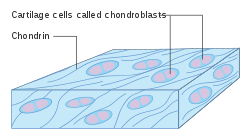
Back أرومة غضروفية Arabic Hondroblast BS Condroblast Catalan Chondroblast German Condroblasto Spanish کندروبلاست Persian Chondroblaste French Condroblasto Italian 軟骨芽細胞 Japanese Хондробласт Kazakh
| Chondroblast | |
|---|---|
 Diagram of chondroblasts | |
| Details | |
| Identifiers | |
| Latin | chondroblastus |
| TH | H2.00.03.5.00002 |
| FMA | 66783 |
| Anatomical terms of microanatomy | |
Chondroblasts, or perichondrial cells, is the name given to mesenchymal progenitor cells in situ which, from endochondral ossification, will form chondrocytes in the growing cartilage matrix. Another name for them is subchondral cortico-spongious progenitors.[1] They have euchromatic nuclei and stain by basic dyes.
These cells are extremely important in chondrogenesis due to their role in forming both the chondrocytes and cartilage matrix which will eventually form cartilage. Use of the term is technically inaccurate since mesenchymal progenitors can also technically differentiate into osteoblasts or fat. Chondroblasts are called chondrocytes when they embed themselves in the cartilage matrix, consisting of proteoglycan and collagen fibers, until they lie in the matrix lacunae. Once they embed themselves into the cartilage matrix, they grow the cartilage matrix by growing more cartilage extracellular matrix rather than by dividing further.[citation needed]
- ^ Krüger, Jan Philipp; Hondke, Sylvia; Endres, Michaela; Pruss, Axel; Siclari, Alberto; Kaps, Christian (2012). "Human platelet-rich plasma stimulates migration and chondrogenic differentiation of human subchondral progenitor cells". Journal of Orthopaedic Research. 30 (6): 845–52. doi:10.1002/jor.22005. PMID 22058056. S2CID 25710553.
© MMXXIII Rich X Search. We shall prevail. All rights reserved. Rich X Search